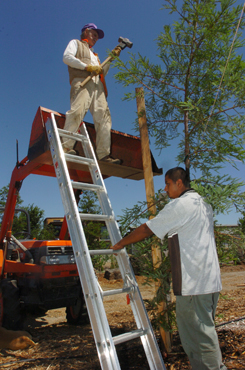
A planned Buddhist temple in Hollister has started landscape
upgrades
Don Belt is living the good life. He spends his free time
digging holes, sinking 12- foot stakes, and moving multiple-ton
boulders with his hired helper, Martin Rangel, more than 50 hours a
week.
As a semi-retired audiologist, he wouldn’t have it any other
way. Belt is performing a labor of love. His long-time dream has
been to construct a Buddhist garden and temple on his five-acre
plot off Riverside Road near Hollister.
A planned Buddhist temple in Hollister has started landscape upgrades
Don Belt is living the good life. He spends his free time digging holes, sinking 12- foot stakes, and moving multiple-ton boulders with his hired helper, Martin Rangel, more than 50 hours a week.
As a semi-retired audiologist, he wouldn’t have it any other way. Belt is performing a labor of love. His long-time dream has been to construct a Buddhist garden and temple on his five-acre plot off Riverside Road near Hollister.
The interest germinated when Belt majored in world religions at the University of Redlands in 1959. He considers himself a Christain, but was always comfortable with other religious philosophies. However, Buddhism, with its synthesis of aesthetics, nature, and philosophy, offers something the doctor can appreciate.
To be called the Hollister Japanese Temple Garden, the project will mimic traditional Japanese temple gardens. It will feature a Shinto shrine, Buddhist temple and teahouse. A large koi pond already exists with more than 40 koi fish imported from Hiroshima.
Belt’s goal with the temple and garden is to provide a spiritual program in a quiet, reflective place for everyone in the community. Services will include weddings, funerals, and general celebrations along with meditation and martial arts practice.
“In keeping with the custom of Singon Buddhism, we are building a traditional sacred Japanese garden to evoke the experience of beautiful and harmonious connection with nature,” Belt said. “At least that’s the dream.”
The garden will consist of a blend of Asian and native-California plants. A section at one end will be predominantly bamboo. Flowering cherry trees will be near the teahouse at the other. Between the two is a 20-ton “welcome stone” surrounded by California Redwoods.
“My greatest pleasure is in seeing the plants grow and the relationship between the old plants and the new,” Belt said. “I love learning about the differences in the soil and the planting and how great an effect that relationship has on one another. I still have much to learn.”
Despite what is already planted, Belt still has much to do. He hopes to have at least 1,000 Emerald Green trees planted by spring of next year. “I want to create a forest atmosphere,” Belt said.
Placement is vital. Sacred Japanese gardens are rigidly formulaic. Everything, from the temple to the rocks, has a special meaning. To help with this process, Belt hired Tadashi Yamada of Gifu, Japan to design both the layout of the garden and buildings.
On one occasion, a temple garden architect consulted Belt on different aspects of the project.
“The first time [the architect] saw the stone, he just stared at it,” Belt said. “He was looking at it from every angle, and after a while he said ‘it’s good, but you should lower it about a half inch on the left side.”
The welcome stone is over 20 feet tall.
The building design and placement is also important. None of the buildings will use nails for support. Joinery, an elaborate Lincoln-log style of construction, must conform to western building codes. The effect will produce the bowed roof typical of ancient Japanese architecture. An avid woodworker, Belt will work with a professional craftsman on the joinery method.
Belt built the future priest’s house along with several other buildings not connected with the Temple Garden. He wants to use the joinery method partly out of interest, partly in keeping with tradition.
The placement of the buildings, including location, direction and height, is equally as important as the garden layout. Each building must comply with the same rigid formula to create a congruous effect. The temple, for example, must be the highest building on the project site. To do so, the ground level must be raised about eight feet where it will sit.
“It’s like the principles of music: harmony, balance, and rhythm. We are trying to get things working together,” Belt said.
However, not everything is determined by architectural feng shui. Some is pure practicality: the bell tower, housing a 2,200-pound bell, must hide the large water filtration system for the koi pond.
In addition to finalizing the physical work at the Temple Gardens, Belt has been seeking the guidance of Shingon priests to forward the spritual agenda.
Just last week, Belt also received guidance from three Singon priests that had come from as far as Seattle. One of the three is a young man, the Rev. Imanaka Taijo, who Belt hopes will become the resident priest next spring.
“We talked about the significance of religion in general and the significance of Buddhism to modern day young people,” Belt said.
Once the project is completed, Belt wants to ensure the Temple Gardens remain a place of happiness and peace. He plans to marry his fiance, Emiko Yamamoto, as the first gesture in the new garden.









